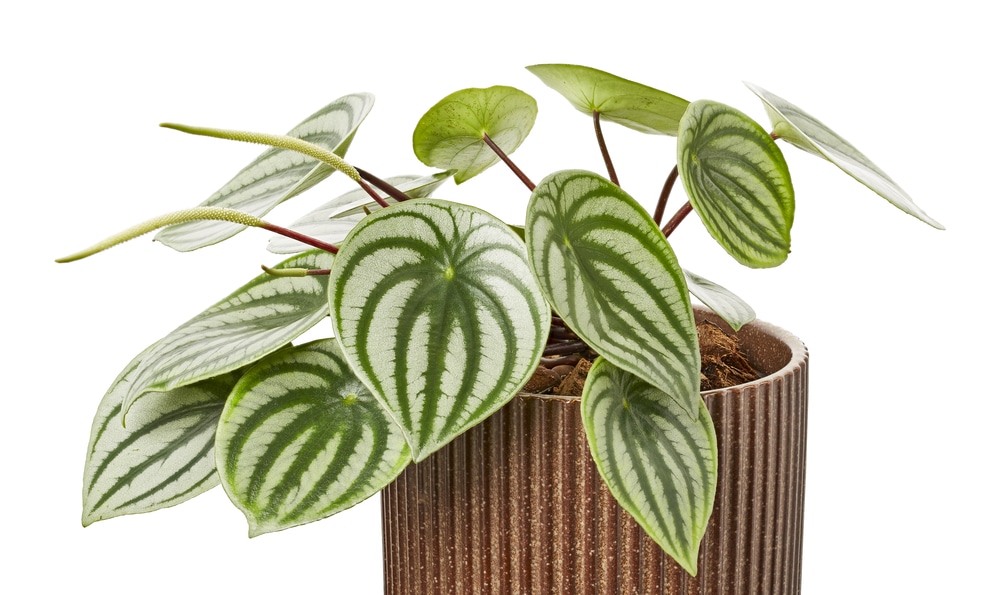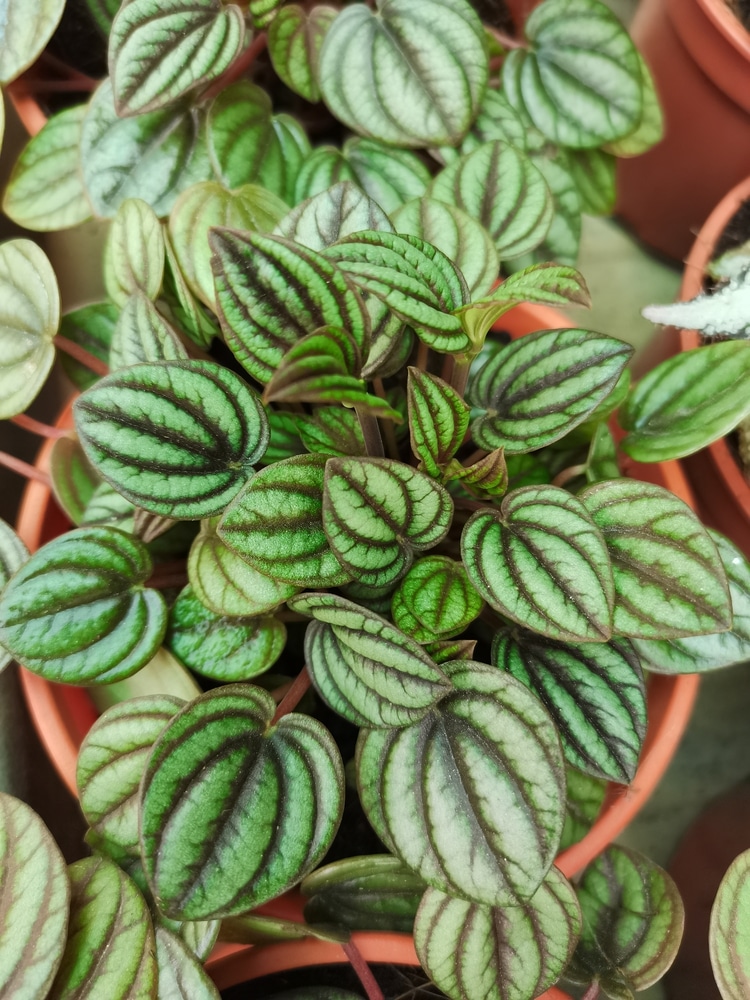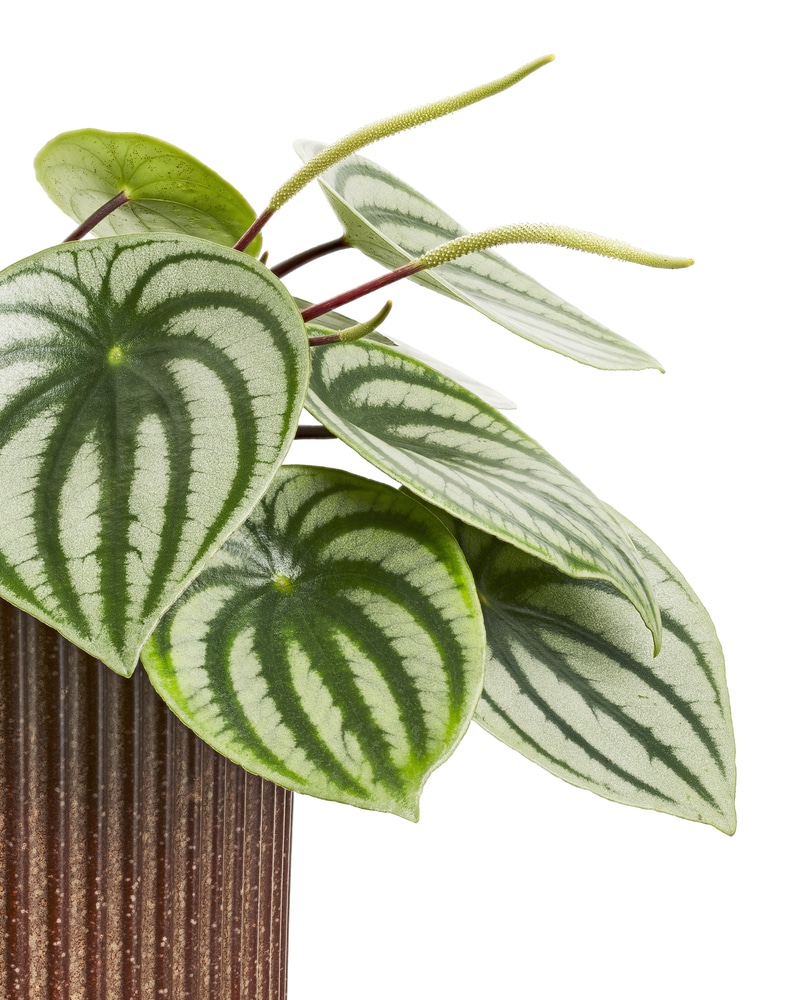This stunning little houseplant with foliage that looks just like a watermelon is irresistible. Peperomia argyreia easily earns its common name, the watermelon peperomia, with its dark green and silver striping and oval leaves. It is a bit of a fussy houseplant, but with the proper care will thrive and show off its spectacular foliage for all to admire.
Peperomia Argyreia Origin & History
The watermelon peperomia is native to northern South America, specifically Brazil. Bolivia, Venezuela, and Ecuador. Exactly when the watermelon peperomia was introduced as a houseplant is unknown, but in Brazil, Peperomia plants are given as gifts to wish someone good luck.
Watermelon peperomia is also commonly known as watermelon begonia because the leaf shape resembles begonias. Peperomia argyreia, though, isn’t related to begonias or watermelons.

All Peperomias are actually members of the pepper family – bell peppers, hot peppers, and Peperomia all are from the Piperaceae family. There are over 1500 Peperomia species, and most are from South and Central America. They all fall under the common name radiator plant because they like warmth (although we don’t suggest actually putting it on a radiator).
The watermelon peperomia is short and broad, rarely growing more than a foot tall. It is more likely to average 6-10 inches in height. Its leaves are small, oval, smooth, waxy, and feature impressive evenly spaced watermelon-striping. The striping is curved on the thick succulent-like leaves to meet at a central point.
Each leaf has a prominent off-center indent where the stem attaches to the underside. This is a unique structure called a peltate leaf – the leaf connects to the stem in the middle instead of at the leaf margin. All the stripes converge or emanate from this one spot, like the top of a watermelon where it is attached to the stem.
Watermelon peperomia foliage looks so watermelon-like it’s a little eerie. The dark-green stripes bleed a little into the silver ones like whoever was painting forgot to clearly mark off the lines. Watermelons, the fruit, feature this same characteristic.
In addition to its impressive watermelon-like attributes, Peperomia argyreia has dark red stems, which cause the houseplant to stand out even more. The stems are thin, and each one holds a single leaf at the top.
In summer may produce thin cream-colored flower spikes. The flower spikes rise above the foliage and have red stalks.
Peperomia argyreia is a synonym for Peperomia sandersii; you may find it under either name.

Peperomia Argyreia Care
In this section we cover important watermelon peperomia care topics such as watering and lighting requirements, potting, fertilizing, temperature, humidity, and more.
Growth Habit
The watermelon peperomia is a relatively slow grower. This little houseplant is bushy and grows 6-12 inches tall, rarely any higher. It will grow about as wide as it is tall, producing a compact yet full display. Even though the plant itself is small, the leaves are large in comparison. They emerge in a rosette-like fashion, creating a dense, grouping appearance. To make an even thicker growth, you can put 2-3 plantlets in one container and let them grow together.
Because the stems are so thin, the connection between them and the leaves is quite fragile. Be extremely careful handling your watermelon peperomia to avoid knocking leaves off.
Lighting
Watermelon peperomias like indirect sunlight or a well-lit room. Direct light isn’t good as it will dry out the leaves. Peperomia argyreia is an understory plant in its tropical home, so it is accustomed to not getting lots of sun.
It doesn’t need to be on a windowsill, as long as there’s a lot of light around. A spot a few feet away from an east or west window is nice. They do well further away as well, with average room light, natural or artificial. A kitchen or office with lots of fluorescent light is excellent.
Watering
Peperomia argyreia is particular about water, and this is where most problems occur. It doesn’t like soggy soil, and it doesn’t like drying out completely, either. This Peperomia likes mostly dry soil that isn’t bone dry. It’s not going to be the same schedule all the time since indoor climates change with the seasons.
The key to optimal watering is always to check the soil beforehand. Don’t guess; stick your finger into the top inch of soil. If it is dry, water thoroughly. But, if the soil is at all moist, wait another couple of days. When it isn’t getting enough water, the leaves wilt and curl rather dramatically.
This tropical plant stores water in its leaves, which is why watering can be a little tricky and why you should wait until it’s mostly dry before watering. The watermelon peperomia will tap into its leaf reserves if it needs to. Overwatering is much more of an issue than underwatering.
In the winter, reduce watering as it won’t need as much since its growth slows down. As a rough guide, plan on watering once every 1-3 weeks in summer and once every 3-5 weeks in winter.
Temperature & Humidity
The ideal temperature range for Peperomia argyreia is between 65-80F. This houseplant likes lots of warmth. This may be an issue in winter – keep an eye on your peperomia to make sure it’s managing okay in the cooler weather. If not, you might want to invest in a couple of grow lights to bring some light and warmth to your tropical houseplant.
Keep the humidity above 50%, and your watermelon peperomia will be happy. If you have a lot of tropical plants struggling, you may want to invest in a humidifier. Or, you can create your own pebble tray humidifier.
To make a DIY pebble tray humidifier, line a pan with pebbles and fill it with water. Place the pot on top of the pan. As the water evaporates, air moisture increases. You’ll need to refill the water regularly.
Keep your peperomia away from hot and cold drafts, vents, or any extreme temperature fluctuations that may stress it out.
Soil & Potting
A well-draining soil is essential, as the watermelon peperomia will suffer if the roots sit in water. Choose a high-quality houseplant potting soil mix and add a couple of handfuls of perlite and coco coir to enhance drainage.
Fertilizer
Add a diluted fertilizer once a month during the growing season. Hold off on fertilizing in winter while your watermelon peperomia is resting.
Pruning
Remove dead or dying leaves when you see them. Otherwise, this houseplant doesn’t need much pruning.
Repotting
Watermelon peperomias like being a bit root bound, so repotting to a larger container isn’t always necessary. However, it is important to refresh the potting soil every year or two to give the houseplant fresh nutrients. If it seems happy, just repot into the same container.
Toxicity
Peperomia argyreia is non-toxic to people and animals. It’s safe to have around the kids and pets, but you may want to put it up high because it’s hard for small children to resist.

Common Pests & Issues
Here are some of the most common pests & issues you may run into when keeping watermelon peperomias.
Root Rot
Signs of root rot include dull or yellow leaves and stalled growth. It happens when a plant is overwatered or is infected with a fungal disease. When the roots become waterlogged, they can’t get enough oxygen and drown. Rotted roots are soft and black. If just a small bit of the roots are mushy, those sections can be cut off. This hopefully will save the plant.
Repot the plant to fresh, clean soil, as well. Compacted soil leads to root rot, as well, since the water is able to drain properly.
Mealybugs, Thrips, Whiteflies, Spider Mites, and Aphids
These small insects are hard to see until they’ve caused considerable trouble. The key is to catch the situation as early as possible by checking the plant often.
Treat these bug infestations with a neem oil solution. Mix two teaspoons neem oil with one teaspoon dish soap in a quart spray bottle. Fill the rest of the bottle with water and shake well. Spray the entire plant, including the leaf tops and underneath, and the stems and soil. Repeat the application of neem oil spray every 4-7 days. Only spray in the morning, so the leaves have time to dry.
Propagating Peperomia Argyreia
The watermelon peperomia is simple to propagate. It is one of the special plants that don’t need a node to propagate – it can be propagated just from a leaf section! Only propagate from a mature and healthy plant.
Stem Cutting Propagation
- Use clean, sterilized scissors to cut a healthy leaf, making sure there are at least 2 inches of stem attached.
- Put the stem cutting in a container with water. Make sure the leaf does not touch the water.
- In 2-3 weeks, small roots will sprout.
- When the roots are at least 1” long, pot up the cutting in a container filled with moistened potting soil.
- It takes a few weeks for the cutting to establish, so be patient.
Leaf Cutting Propagation
- Cut off a piece of the leaf perpendicular to the stripes.
- Put the leaf cutting in damp potting soil, cut side down. Just the very tip of the leaf should be in the dirt.
- Cover the container with a plastic bag, leaving one corner open for airflow. This increases the humidity.
- Keep the humidity high by lightly misting every day, but don’t let the soil get too wet.
- In 3-4 weeks, roots will form from the leaf.
Common Questions & Troubleshooting
Here are some of the most common questions we’ve been asked about keeping watermelon peperomias.
What is causing the leaves of my watermelon peperomia to split?
This is due to not having enough moisture. The leaves are drying out and cracking. To remedy this, first, make sure the soil is moist and not completely dried out. If that is fine, then it’s a matter of insufficient humidity. Peperomias like high humidity and dry air sucks moisture from the foliage.
Try misting the leaves in the morning (always the morning, so the water has time to evaporate during the day). Get a humidifier or make a pebble tray humidifier if that isn’t enough.
What are the brown spots on the leaf undersides of my Peperomia argyreia?
Brown spots are usually due to overwatering or insufficient nutrition. Make sure the soil is drying out between watering. If you haven’t added fertilizer recently, try giving your Peperomia some plant food to get it healthy again.
Why are the leaves of my Peperomia argyreia curling?
Curling leaves are a sure sign of underwatering. The leaves turn inwards as a means of self-defense, which aids in water conservation. Check the soil for moisture content and water thoroughly. It may be that the soil isn’t retaining water properly, especially if the plant hasn’t been repotted in a long time. Try repotting if a deep watering doesn’t do the trick. Give it a week after watering to recover first, though, before trying repotting.
Are Watermelon Peperomia plants succulents?
No. They look and act like it, but they are not part of the succulent family. Peperomias require more moisture and humidity than succulents.
Why are the leaves dropping off of my watermelon peperomia?
Leaves will drop off if the room temperature is too cold. This stresses out the foliage, sending it into shock. The temperature should be at least 60F.
Leaf drop also happens due to overwatering. Constantly wet soil is also a stress to the peperomia, and it may cause the roots and stem to rot, which will then cause the leaves to fall off. Check that the leaf stems aren’t mushy.
While the watermelon peperomia is finicky about watering, the rest of its care is beyond easy. This stunning houseplant with the impossible to resist watermelon-like foliage deserves a front and center location in the home. Its cheerful persona and brilliant contrasting colors will light up any house.

